Characterization of the Dynamic Properties of Clay–Gravel Mixtures at Low Strain Level
Abstract
:1. Introduction
2. Preparation for Specimen and Test Scheme
2.1. Experimental Clay
2.2. Experimental Gravels
2.3. Preparation for Specimen
2.4. Experimental Scheme
3. Improved Resonant Column Device and Measuring Process
3.1. Description of the Improved Resonant Column
3.2. Testing Process
3.2.1. Installation Process of the Specimen
3.2.2. Testing Process and Data Deal
4. Results and Discussion about the Dynamic Shear Modulus
4.1. Dynamic Shear Modulus
4.2. Maximum Dynamic Shear Modulus
4.3. Referent Shear Strain
5. Results and Discussion about the Damping Ratio
5.1. Damping Ratio
5.2. Minimum Damping Ratio
5.3. Maximum Damping Ratio
6. Conclusions
- (1)
- For measuring the dynamic properties of soft materials (those that cannot stand without confining pressure) at low strain, improvements regarding the resonant column of GZZ-50 type were conducted and the corresponding installation and data deal processes were detailed.
- (2)
- The relationship of the dynamic shear modulus and the damping ratio with different confining pressures and gravel contents were obtained, in which, with the increase of confining pressure and gravel content in the CGMs, the dynamic shear modulus shows an increasing tendency and the damping ratio shows a decreasing tendency to different degrees.
- (3)
- According to Hardin’s fitting results, the relationship of Gmax and γr with different confining pressures, gravel contents, and shapes was obtained. With the increase of gravel content, Gmax shows three different increasing phases, including 0–10% (low increasing amplitude), 10–40% (high increasing amplitude), and 40–60% (increasing amplitude seriously affected by confining pressure), owing to the better shear wave transfer effect of gravels. With the increase of confining pressure, Gmax shows a nonlinear increasing tendency that is related to the compaction effect of CGMs. CGMr has greater Gmax than CGMa when the gravel content is over 50%, and less of a difference appears when the gravel content is smaller than 50%.
- (4)
- The γr of the CGMs linearly increases with an increase in gravel content, and shows a nonlinear increase with the increase of confining pressure; in addition, the γr of CGMa is greater than CGMr, which is due to the interlock effect of angular gravels.
- (5)
- Based on the testing results and Chen’s fitting equation, the Dmin of the CGMs linearly decreases with the increase in gravel contents, and nonlinearly decreases with the increase in confining pressure; CGMr has a lower Dmin than CGMa.
- (6)
- Based on Chen’s fitting equation, the Dmax of the CGMs decreases with an increase in gravel content and confining pressure; CGMa has a smaller Dmax than CGMr when the gravel content is over 30%, and the influence of gravel shape on the Dmax of the CGMs is not clear when the gravel content is smaller than 30%.
- (7)
- For better supporting the design of subgrade filling engineering with CGMs, the prediction equations of Gmax, γr, Dmin, and Dmax, considering different confining pressures (0–300kPa), gravel contents (0–60%), and shapes (round and angular), were obtained.
Author Contributions
Funding
Conflicts of Interest
References
- Zhang, Z.X.; Xu, X.J.; Zhang, H.Y. Large-scale in-situ test for mechanical characterization of soil–rock mixture used in an embankment dam. Int. J. Rock. Mech. Min. 2016, 86, 317–322. [Google Scholar] [CrossRef]
- Zhang, H.Y.; Xu, W.J.; Yu, Y.Z. Triaxial tests of soil–rock mixtures with different rock block distributions. Soils. Found. 2016, 56, 44–56. [Google Scholar] [CrossRef] [Green Version]
- Liu, S.Q.; Huang, X.W.; Zhou, A.Z.; Hu, J.; Wang, W. Soil-Rock Slope Stability Analysis by Considering the Nonuniformity of Rocks. Math. Probl. Eng. 2018, 1–15. [Google Scholar] [CrossRef]
- Wang, W.; Zhang, C.; Guo, J.; Li, N.; Li, Y.; Zhou, H.; Liu, Y. Investigation on the triaxial mechanical characteristics of cement-treated subgrade soil admixed with polypropylene fiber. Appl. Sci. 2019, 21, 4557. [Google Scholar] [CrossRef] [Green Version]
- Zhang, D.; Li, Q.M.; Liu, E.L.; Liu, X.Y.; Zhang, G.; Song, B.T. Dynamic properties of frozen silty soils with different coarse-grained contents subjected to cyclic triaxial loading. Cold. Reg. Sci. Technol. 2019, 157, 64–85. [Google Scholar] [CrossRef]
- Lin, B.; Zhang, F.; Feng, D.; Tang, K.; Feng, X. Dynamic shear modulus and damping ratio of thawed saturated clay under long-term cyclic loading. Cold. Reg. Sci. Technol. 2018, 145, 93–105. [Google Scholar] [CrossRef]
- Li, N.; Zhu, Q.Y.; Wang, W.; Song, F.; An, D.L.; Yan, H.R. Compression characteristics and microscopicmechanism of coastal soil modified with cementand fly ash. Materials 2019, 12, 3182. [Google Scholar] [CrossRef] [Green Version]
- Li, W.; Lang, L.; Wang, D.; Wu, Y.; Li, F.D. Investigation on the dynamic shear modulus and damping ratio of steel slag sand mixtures. Constr. Build. Mater. 2018, 162, 170–180. [Google Scholar] [CrossRef]
- Cevik, A.; Cabalar, A.F. Modelling damping ratio and shear modulus of sand–mica mixtures using genetic programming. Expert. Syst. Appl. 2009, 36, 7749–7757. [Google Scholar] [CrossRef]
- Okur, D.V.; Ansal, A. Stiffness degradation of natural fine grained soils during cyclic loading. Soil. Dyn. Earthq. Eng. 2007, 27, 843–854. [Google Scholar] [CrossRef]
- Wang, Y.; Wang, L.Y. Study of effects of fines content on dynamic elastic modulus and damping ratio of saturated sand. Rock. Soil. Mech. 2011, 32, 2623–2628. (In Chinese) [Google Scholar]
- Geng, M.; Wang, D.B.; Li, P.Y. Undrained dynamic behavior of reinforced subgrade under long-term cyclic loading. Adv. Mater. Sci. Eng. 2018, 1–9. [Google Scholar] [CrossRef] [Green Version]
- Wu, Z.J.; Zhang, D.; Zhao, T.; Ma, J.L.; Zhao, D.Y. An experimental research on damping ratio and dynamic shear modulus ratio of frozen silty clay of the Qinghai-Tibet engineering corridor. Transp. Geotech. 2019, 21, 100269. [Google Scholar] [CrossRef]
- Xu, D.S.; Liu, H.B.; Rui, R.; Gao, Y. Cyclic and postcyclic simple shear behavior of binary sand-gravel mixtures with various gravel contents. Soil. Dyn. Earthq. Eng. 2019, 123, 230–241. [Google Scholar] [CrossRef]
- Wichtmann, T.; Navarrete, M.A.; Triantafyllidis, T. On the influence of a non-cohesive fines content on small strain stiffness, modulus degradation and damping of quartz sand. Soil. Dyn. Earthq. Eng. 2015, 69, 103–114. [Google Scholar] [CrossRef]
- Sun, T.; Chen, G.X.; Wang, B.H.; Li, X.J. Experimental research of effect of granule shape on shear modulus and damping ratio of gravel. J. Rock Mech. Eng. 2014, 33, 4211–4217. (In Chinese) [Google Scholar]
- Meidani, M.; Shafiee, A.; Habibagahi, G.; Jafari, M.K.; Mohri, Y.; Ghahramani, A. Granule shape effect on the shear modulus and damping ratio of mixed gravel and clay. Iran. J. Sci. Technol. 2008, 32, 501. [Google Scholar]
- Bouwman, A.M.; Bosma, J.C.; Vonk, P.; Wesselingh, J.H.A.; Frijlink, H.W. Which shape factor(s) best describe granules. Powder. Technol. 2004, 146, 66–72. [Google Scholar] [CrossRef]
- Payan, M.; Khoshghalb, A.; Senetakis, K.; Khalili, N. Small-strain stiffness of sand subjected to stress anisotropy. Soil. Dyn. Earthq. Eng. 2016, 88, 143–151. [Google Scholar] [CrossRef]
- Lu, Z.C.; Yao, A.G.; Su, A.J.; Ren, X.W.; Liu, Q.B.; Dong, S. Re-recognizing the impact of particle shape on physical and mechanical properties of sandy soils. Eng. Geol. 2019, 253, 36–46. [Google Scholar] [CrossRef]
- Junhwanm, L.; Rodrigo, S.J. Stiffness degradation and shear strength of silty sands. Can. Geotech. J. 2011, 41, 831–843. [Google Scholar]
- Darendeli, M.B. Development of a new family of normalized modulus reduction and material damping curves. PhD Thesis, University of Texas at Austin, Austin, USA, 2001. Available online: https://repositories.lib.utexas.edu/handle/2152/10396 (accessed on 1 December 2019).
- Wang, W.; Zhang, C.; Li, N.; Tao, F.F.; Yao, K. Characterisation of nano magnesia-cement-reinforced seashore soft soil by direct-shear test. Mar. Georesour. Geotechnol. 2019, 37, 989–998. [Google Scholar] [CrossRef]
- Payan, M.; Chenari, R.J. Small strain shear modulus of anisotropically loaded sands. Soil. Dyn. Earthq. Eng. 2019, 125, 105726. [Google Scholar] [CrossRef]
- Senetakis, K.; Payan, M. Small strain damping ratio of sands and silty sands subjected to flexural and torsional resonant column excitation. Soil. Dyn. Earthq. Eng. 2018, 114, 448–459. [Google Scholar] [CrossRef]
- Chong, S.; Kim, J. Nonlinear vibration analysis of the resonant column test of granular materials. J. Sound. Vib. 2017, 393, 216–228. [Google Scholar] [CrossRef]
- Jin, D.D.; Huang, X.W.; Wang, B.H.; Zhou, A.Z.; Liu, S.Q. Method Improvements of Testing Modulus of Soil Based on Free-Vibration Column. Adv. Civil. Eng. 2019, 1–9. [Google Scholar] [CrossRef]
- Chinese National Geotechnical Test Standard, GB/T 50123-1999, China Planning Press. 1999. Available online: http://www.zys168.net/Upload/DownLoad/DownLoadFile/20107191920846.pdf (accessed on 26 October 2019). (In Chinese).
- Yao, K.; Li, N.; Chen, D.H.; Wang, W. Generalized hyperbolic formula capturing curing period effect on strength and stiffness of cemented clay. Constr. Build. Mater. 2019, 199, 63–71. [Google Scholar] [CrossRef]
- Xu, W.J.; Xu, Q.; Hu, R.L. Study on the shear strength of soil–rock mixture by large scale direct shear test. Int. J. Rock. Mech. Min. 2011, 48, 1235–1247. [Google Scholar]
- Wang, Y.; Li, X.; Zheng, B. Stress-strain behavior of soil-rock mixture at medium strain rates–Response to seismic dynamic loading. Soil. Dyn. Earthq. Eng. 2017, 93, 7–17. [Google Scholar] [CrossRef]
- Sun, Q.; Zheng, J.; Coop, M.R.; Altuhafi, F.N. Minimum image quality for reliable optical characterizations of soil particle shapes. Comput. Geotech. 2019, 114, 103110. [Google Scholar] [CrossRef]
- Donaghe, R.T.; Torrey, V.H. Proposed new standard test method for laboratory compaction testing of soil-rock mixtures using standard effort. Geotech. Test. J. 1994, 17, 387–392. [Google Scholar]
- Yao, K.; Wang, W.; Li, N.; Zhang, C.; Wang, L.X. Investigation on strength and microstructure characteristics of Nano-MgO admixed with cemented soft soil. Constr. Build. Mater. 2019, 206, 160–168. [Google Scholar] [CrossRef]
- Gong, J.; Nie, Z.H.; Zhu, Y.G.; Liang, Z.Y.; Wang, X. Exploring the effects of particle shape and content of fines on the shear behavior of sand-fines mixtures via the DEM. Comput. Geotech. 2019, 106, 161–176. [Google Scholar] [CrossRef]
- Saxena, S.K.; Reddy, K.R. Dynamic modulic and damping ratios for Monterey sand by resonant column tests. Soil. Mech. Found. Eng. 1989, 29, 37–51. [Google Scholar] [CrossRef] [Green Version]
- Hardin, B.O. Shear modulus and damping in soils: Measurement and parameter effects. Soil. Mech. Found. Eng. 1972, 98, 603–624. [Google Scholar]
- Huang, J.Y.; Xu, S.L.; Hu, S.S. Influence of particle breakage on the dynamic compression responses of brittle granular materials. Mech. Compos. Mater. 2014, 68, 15–28. [Google Scholar] [CrossRef]
- Kim, J.W.; Chong, S.H.; Cho, G.C. Experimental Characterization of Stress- and Strain-Dependent Stiffness in Grouted Rock Masses. Materials 2018, 11, 524. [Google Scholar] [CrossRef] [Green Version]
- Wang, Y.Q.; Tan, Y.Q.; Guo, M.; Wang, X.L. Influence of Emulsified Asphalt on the Mechanical Property and Microstructure of Cement-Stabilized Gravel under Freezing and Thawing Cycle Conditions. Materials 2017, 10, 504. [Google Scholar] [CrossRef] [Green Version]
- Sun, Y.F.; Nimbalkar, S.; Chen, C. Particle breakage of granular materials during sample preparation. J. Rock. Mech. Geo. Eng. 2019, 11, 417–422. [Google Scholar] [CrossRef]
- Shi, S.Y.; Li, S.F.; Liu, L.B.; Li, Y. Experimental study on dynamic shear modulus and damping ratio of silty sand in Handan. Wor. Earthq. Eng. 2012, 28, 95–99. (In Chinese) [Google Scholar]
- Delfosseribay, E.; Djeranmaigre, I.; Cabrillac, R.; Gouvenot, D. Shear modulus and damping ratio of grouted sand. Soil. Dyn. Earthq. Eng. 2004, 24, 461–471. [Google Scholar] [CrossRef]
- Chen, G.X.; Zhou, Z.L.; Sun, T. Shear Modulus and Damping Ratio of Sand–Gravel Mixtures Over a Wide Strain Range. J. Earthquake. Eng. 2019, 23, 1407–1440. (In Chinese) [Google Scholar] [CrossRef]
- Li, H.W.; Senetakis, K.; Matthew, R.C. Medium-strain dynamic behavior of fiber-reinforced sand subjected to stress anisotropy. Soil. Dyn. Earthq. Eng. 2019, 126, 105764. [Google Scholar] [CrossRef]



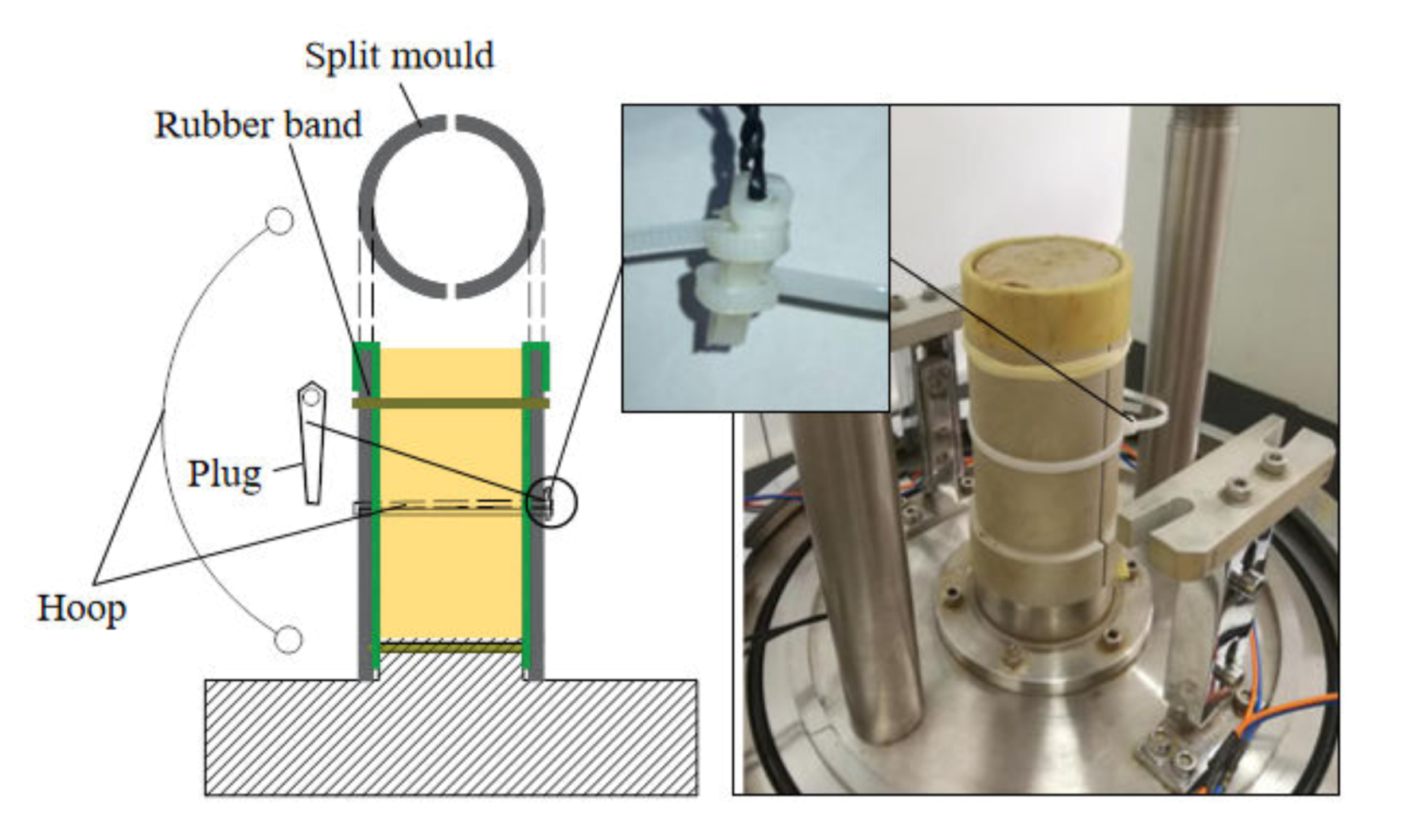


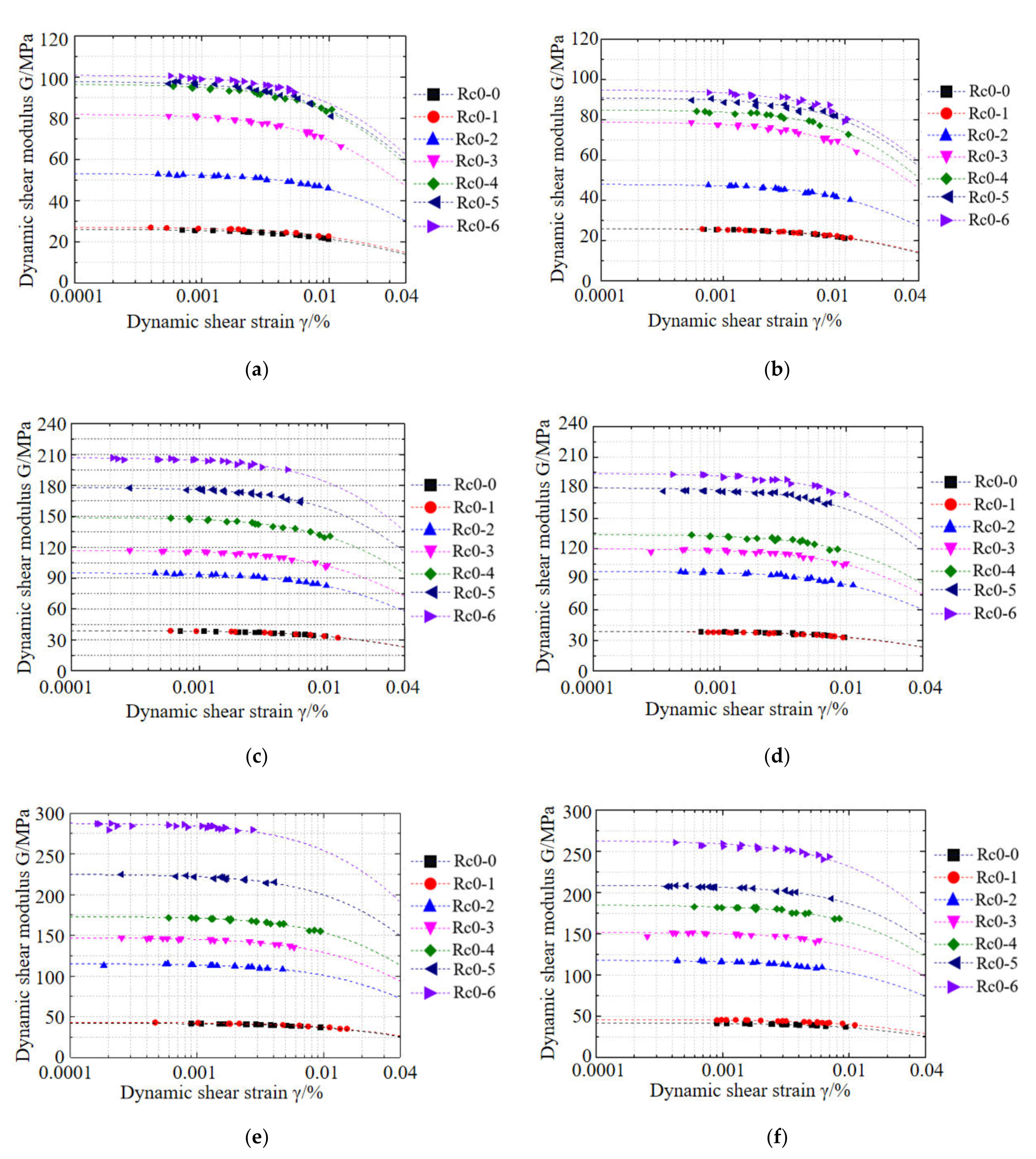

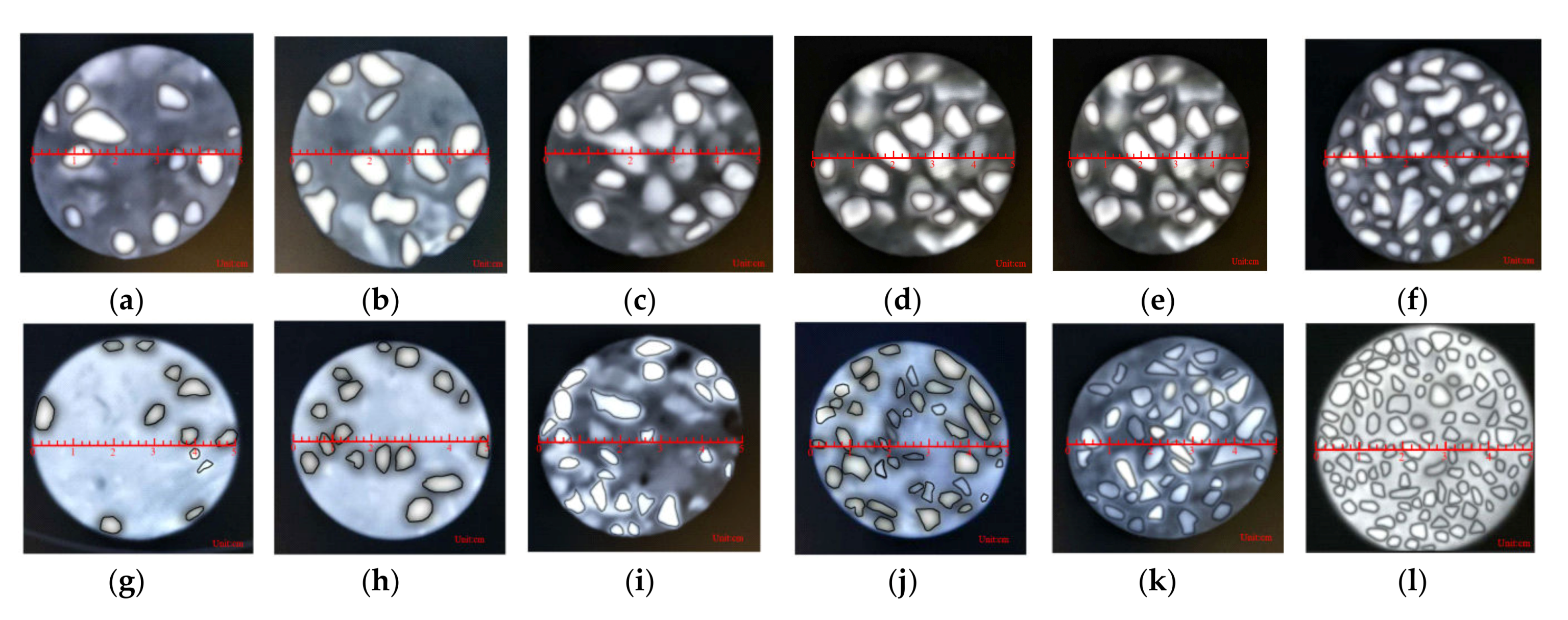

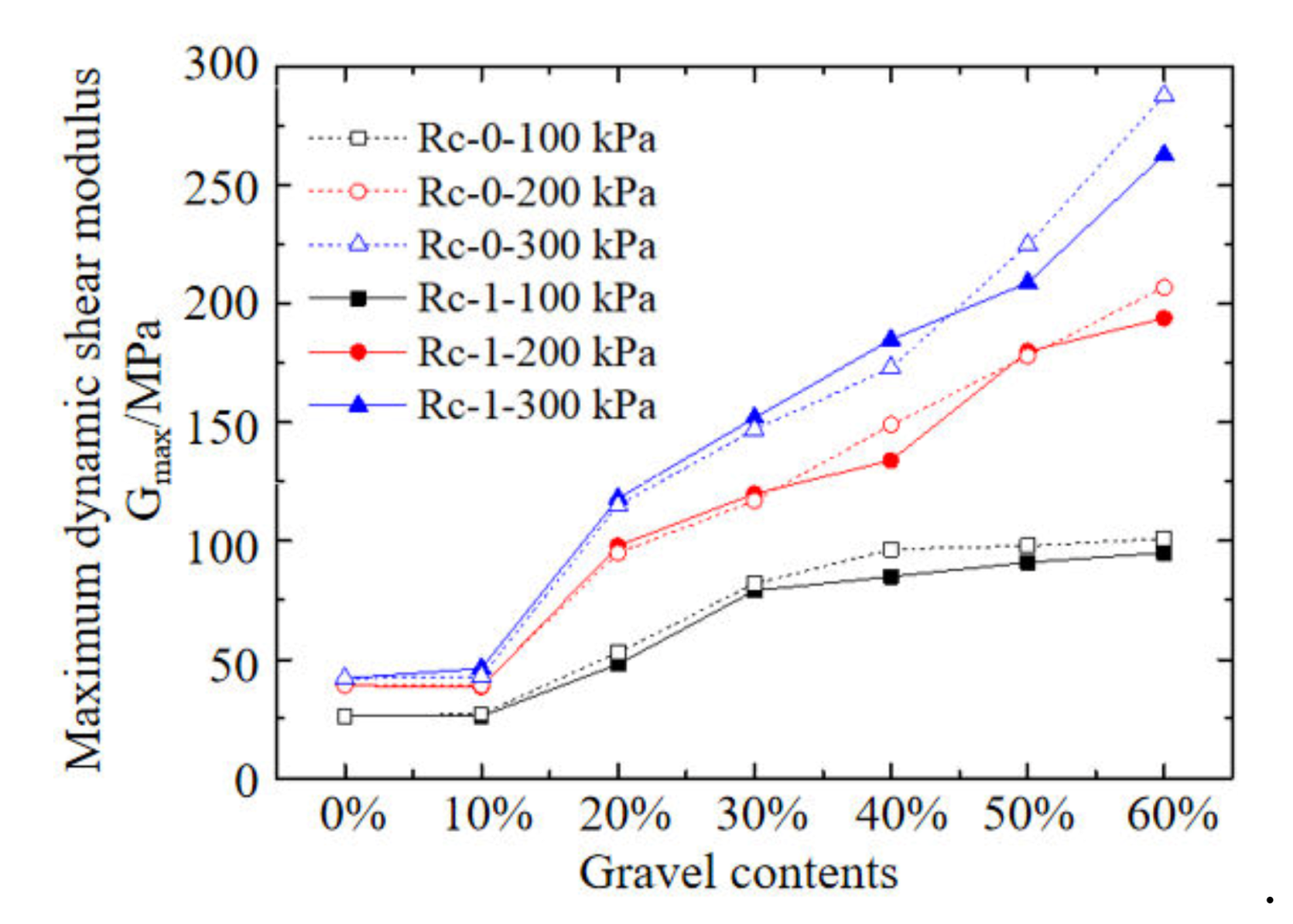
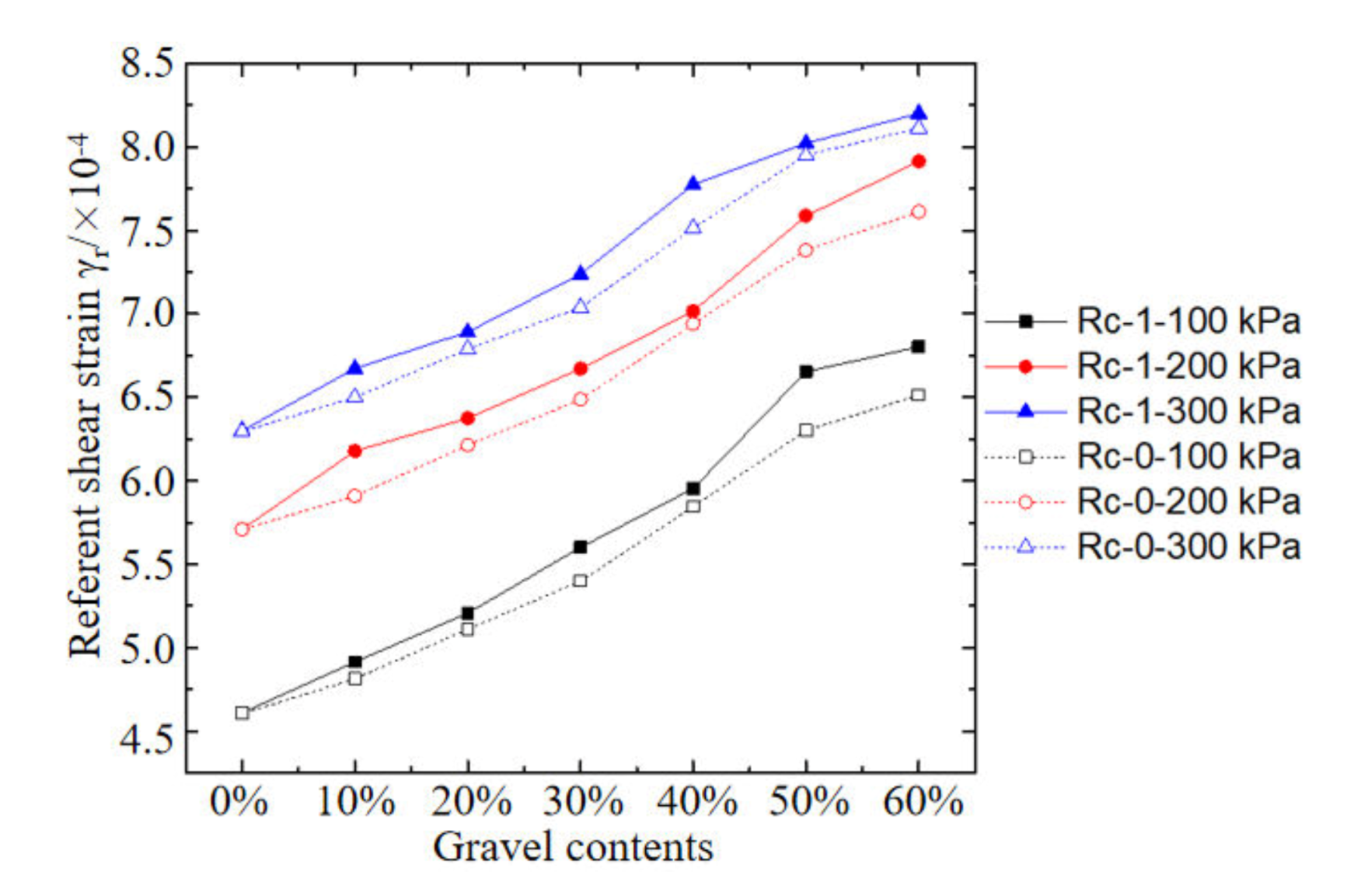



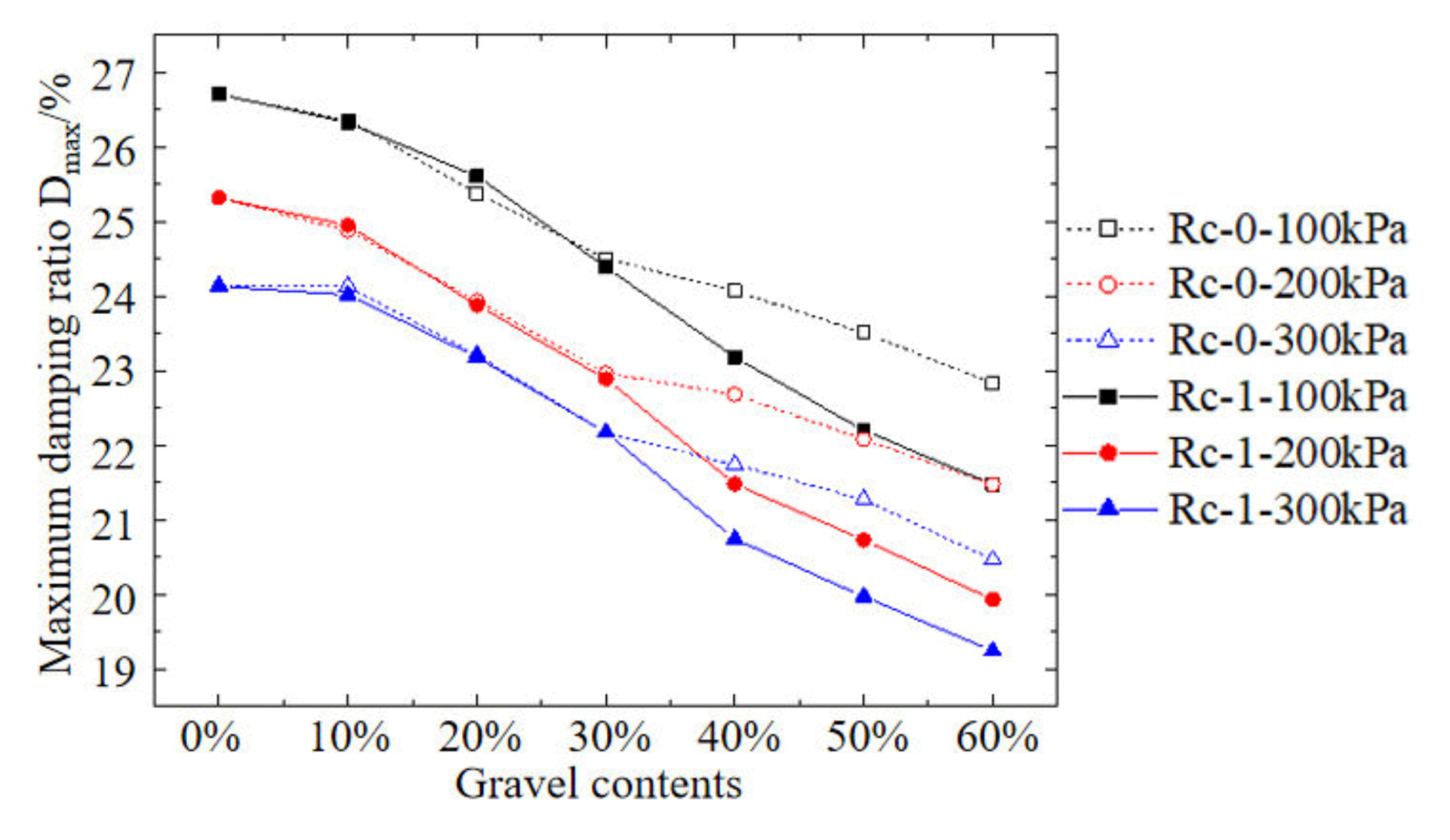
| Item | Specific Gravity | Liquid Limit | Plastic Limit | Plasticity Index | Optimized Water Content | Expansion Ratio |
|---|---|---|---|---|---|---|
| Value | 2.75 | 43.2% | 20.2% | 23% | 15% | 41% |
| Standard deviation | 0.006 | 0.8% | 0.5% | - | 0.2% | 0.6% |
| Sample Number | Gravel Shape | Gravel Content | Confining Pressure σ (kPa) | Sample Number | Gravel Shape | Gravel Content | Confining Pressure σ (kPa) |
|---|---|---|---|---|---|---|---|
| Rc-0-0 | Round | 0% | 100, 200, 300 | Rc-1-0 | Angular | 0% | 100, 200, 300 |
| Rc-0-1 | 10% | 100, 200, 300 | Rc-1-0 | 10% | 100, 200, 300 | ||
| Rc-0-2 | 20% | 100, 200, 300 | Rc-1-0 | 20% | 100, 200, 300 | ||
| Rc-0-3 | 30% | 100, 200, 300 | Rc-1-0 | 30% | 100, 200, 300 | ||
| Rc-0-4 | 40% | 100, 200, 300 | Rc-1-0 | 40% | 100, 200, 300 | ||
| Rc-0-5 | 50% | 100, 200, 300 | Rc-1-0 | 50% | 100, 200, 300 | ||
| Rc-0-6 | 60% | 100, 200, 300 | Rc-1-0 | 60% | 100, 200, 300 |
© 2020 by the authors. Licensee MDPI, Basel, Switzerland. This article is an open access article distributed under the terms and conditions of the Creative Commons Attribution (CC BY) license (http://creativecommons.org/licenses/by/4.0/).
Share and Cite
Huang, X.; Zhou, A.; Wang, W.; Jiang, P. Characterization of the Dynamic Properties of Clay–Gravel Mixtures at Low Strain Level. Sustainability 2020, 12, 1616. https://doi.org/10.3390/su12041616
Huang X, Zhou A, Wang W, Jiang P. Characterization of the Dynamic Properties of Clay–Gravel Mixtures at Low Strain Level. Sustainability. 2020; 12(4):1616. https://doi.org/10.3390/su12041616
Chicago/Turabian StyleHuang, Xianwen, Aizhao Zhou, Wei Wang, and Pengming Jiang. 2020. "Characterization of the Dynamic Properties of Clay–Gravel Mixtures at Low Strain Level" Sustainability 12, no. 4: 1616. https://doi.org/10.3390/su12041616







